Working on the railway: The women who kept Britain on track
- Published

Some people said women calling out station names was "unfeminine"
A database has been launched containing the details of 20,000 railway workers who died in World War I.
It has taken the National Railway Museum, in York, more than two years to build its searchable list of workers' names, ranks, military numbers, rail departments and occupations, addresses, family details, dates of death and which war memorial they are on along with 4,500 references to photographs in staff magazines.
Alison Kay, assistant archivist, said: "This database has been a few years in the making and we are delighted to now make it accessible.
"We're looking forward to welcoming people who want to look up details of former family members, friends or neighbours that may have died in the wars.
"In due course we'd love to hear from anyone who uses our database and finds information they find useful. We plan to keep on adding to the list over the coming years."
While highlighting the massive losses in just one section of industry during the war, the list also draws attention to the role women played in keeping Britain moving.
Helen Ashby, head of knowledge and collections at the National Railway Museum, said the first women rail workers were level crossing gatekeepers - a role that fitted in with family life.
The job was often given to widows with children and came with either a small salary or a rent free home.
By the turn of the century nearly half of the women employed by the railway companies worked in hotels and catering.
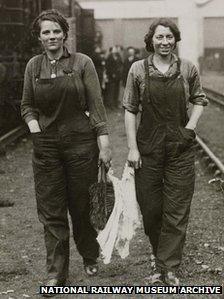
Railway companies began issuing trouser overalls to women
Roles were traditionally female like cooks, kitchen assistants, cleaners, housemaids, waitresses, laundrywomen, stores women, cloakroom attendants and chambermaids.
In addition by 1914 about 900 women worked in railway workshops as skilled trimmers, French polishers or sewing machinists producing the finely upholstered and polished hardwood interiors of railway coaches.
Ms Ashby said: "For so long working in the railways was seen as 'men's work' but women have played integral roles in the rail industry throughout history."
On 4 August 1914, Britain declared war on Germany - just one month later nearly 100,000 railwaymen had left to fight in the trenches and the transport of vital supplies to the front line was threatened.
She said: "It was during the world wars that women were fully drafted in ensuring that the rail industry kept going through such a difficult period."
Over the next three years women were recruited to do most of the jobs left vacant by men except driving trains and firing engines because the training period was too long.
'Station stories'
By 1918 the number of women carrying out clerical, telephone and telegraph duties had risen tenfold.
In Britain's railway workshops the number of unskilled women labourers increased from 43 in 1914 to 2,547 by 1918. They tackled portering, varnishing and painting engines, sweeping, storekeeping and cleaning.
To celebrate their role the museum has a permanent display about women working on the railways.
Press officer Kate Maughan-Brown said the museum was currently redeveloping its station hall and as part of this had collected a range of "station stories" to help interpret the collection.
She said: "This includes a good number of social history stories from women. The new interpretation includes audiovisual effects including a steam machine and is planned to be completed by the end of February, but work is already under way."
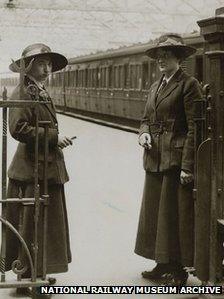
Women became ticket collectors on every major railway
According to the museum, women faced opposition as they took up their new roles - some people disapproved of women calling out station names saying it was "unfeminine and immodest".
They were also criticised for wearing men's breeches despite the fact some tasks were impossible or dangerous to do in a long skirt.
Until April 1915 women were paid two-thirds less than their male counterparts until the railway unions admitted women and the National Union of Railwaymen demanded that companies should pay women at least the minimum male wage for the job.
As the war progressed women took on the better paid but more hazardous posts of track maintenance platelayer, shunter and guard.
The position of railway police officer was opened in 1917.
When the war ended in 1918 women were expected to hand their jobs back to the men they had replaced but many were retained and the number of women employed by the railways never fell to its pre-war level.
The wartime trailblazers were the first of hundreds of women to forge careers in the rail industry but they were far from the last.
The industry began to change as a result of the 1975 Sex Discrimination Act which made discrimination at work based on sex or marital status illegal.
The number of women management trainees rose from none in 1975 to 20 in 1981 and women were also accepted for driver training.
Ms Ashby said: "From cleaning to signalling, women today play a key part in all aspects of railway work."
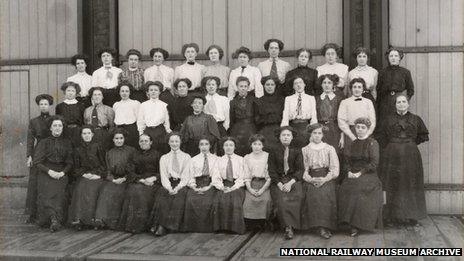
Before World War I women were employed on the railways in traditional female roles as cooks and cleaners
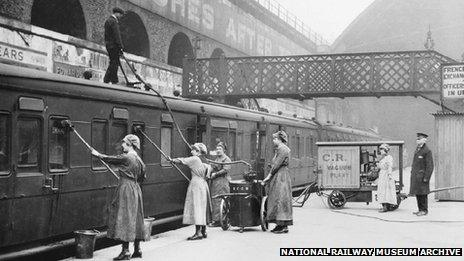
Engine cleaning was one of the filthiest jobs on the railways
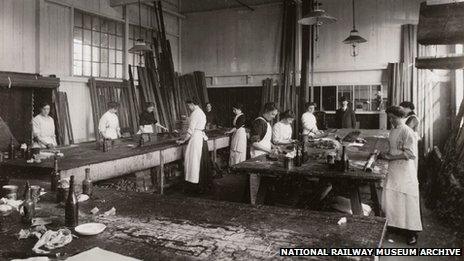
Women carried out French polishing on the wood inside first class railway carriages
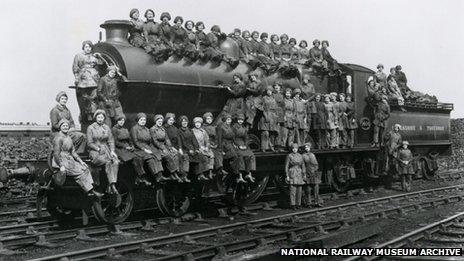
Women were paid two-thirds less than their male counterparts until 1915
- Published8 November 2012
- Published6 September 2012
- Published8 July 2012
- Published23 April 2012